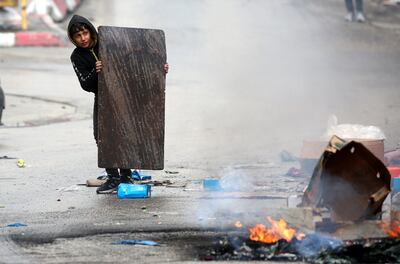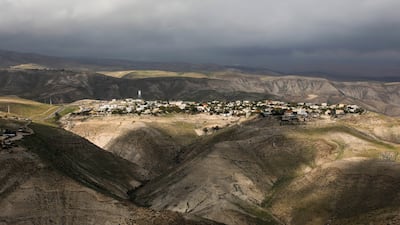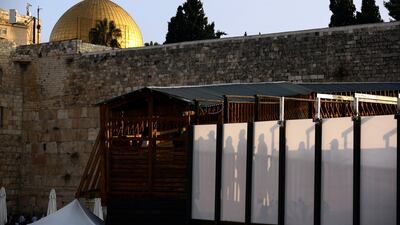At its core, the struggle over the future of Jerusalem isn’t only about religion. Though it may sound sacrilegious to some, the core issue extends beyond historical claims to holy sites or who gets to pray where and when. It’s also about power. Specifically, it’s about Israel’s objective to flaunt its power, while Palestinians make a last-ditch effort to salvage some shred of control over their lives.
This power struggle can be viewed through many lenses, but nowhere is it more clearly visible than in the tale of two Palestinian cities – East Jerusalem and Hebron – and the connections that bind their fate.
In 1994, after Baruch Goldstein, an extremist Israeli settler, massacred 29 Palestinian worshippers in Hebron’s Al Ibrahimi Mosque, the Israelis imposed several repressive measures that particularly affected Hebron and Jerusalem. The Israelis claimed that they implemented these measures in order to pre-empt any Palestinian retaliation for the massacre. And so, while an Israeli committed the crime, it was the Palestinians who paid the price.
In Hebron, Palestinians living in close proximity to the few hundred Israeli settlers who had illegally occupied buildings on Shuhada Street were evicted from their homes. Additionally, the Israeli military deployed more than a thousand well-armed soldiers and closed off major streets effectively shutting down the souq.
Where thousands of Hebronites once strolled and shopped, now there were empty streets and closed shops with graffiti covering the walls of Arab shops: Hebrew slogans reading "Death to the Arabs” and “Goldstein is our hero".
The fate of Jerusalem and Hebron are connected for two reasons
The stress and hardship this placed on Hebron was obvious, as was the disruption to the economic and professional well-being of the Palestinians who lived in the neighbouring towns and villages of the Hebron district. To protect the settlers travelling from the nearby settlement of Kiryat Arba, the Israeli military established numerous checkpoints and closed side roads. The situation borders on the absurd. Residents from two Palestinian villages could no longer drive the short distance to Hebron to shop and visit with relatives and friends. The route was cut by military blockades at two points, about 50 metres apart. Arabs driving from the villages were forced to park on one side and then walk to the next barricade to secure a taxi into Hebron.
Settler rioting, empty Arab shops, police beatings of Palestinians, the closure of the old city and the destruction of its economy, the daily harassment and pressure – this became daily life.
Equally distressing were the measures the Israelis implemented at Al Ibrahimi Mosque, the scene of the massacre. They took complete control of the building and physically divided it into Jewish and Muslim sections, with almost two-thirds reserved for a Jewish synagogue. While Israelis have relatively free access to the building, Palestinians are forced to wait in humiliating lines and pass through numerous Israeli-controlled checkpoints to enter. To add insult to injury, on dates of religious importance to Judaism, Israelis routinely close the entire mosque and its surroundings to Palestinians. And recently, Israel announced plans to seize land around the mosque to build a lift to provide access for Jewish worshippers.
I say that the fate of Jerusalem and Hebron are connected for two reasons. First, as part of the “protective” measures taken post-Goldstein, Israel instituted the complete closure of East Jerusalem from the rest of the West Bank. This closure was even more complete than the one instituted in Hebron, with profound economic, social, cultural, political, and even psychological consequences for the Palestinian population of East Jerusalem.
The absence of jobs and opportunities for the young Palestinians in Jerusalem has produced both cynicism and despair, as has the closure, which, for all intents and purposes, cut the heart of Palestine away from the rest of its body.
Like their kinfolk in Hebron, as they lost control over their lives and futures, Palestinians in Jerusalem lost hope. And as they witness increasing settlement construction, land confiscations, and home demolitions as part of Israel’s effort to “Judaise” the city, that loss of hope has turned to resentment and resistance.
The one place, indeed the only place, where Palestinians feel any semblance of control is at Haram Al Sharif and Al Aqsa Mosque. And this brings me to the second reason why the fate of the two cities is inextricably linked.
When Palestinians see the increased numbers of heavily guarded Israelis invading the Haram area, the acts of incitement that accompany these “visits", and the declared intent of Israeli extremists to seize control of the area, they feel profoundly threatened. Their reaction is not as Israeli National Security Minister Itamar Ben-Gvir, a senior member of the current Israeli government, claims born of racism or anti-Semitism. Rather, it’s because they fear that what happened to Al Ibrahimi Mosque is what the future holds for Al Aqsa. And this they can’t abide. It is a religious issue to be sure, but, at its core, it’s about their need to protect the last semblance of control they feel they have.
What is blockchain?
Blockchain is a form of distributed ledger technology, a digital system in which data is recorded across multiple places at the same time. Unlike traditional databases, DLTs have no central administrator or centralised data storage. They are transparent because the data is visible and, because they are automatically replicated and impossible to be tampered with, they are secure.
The main difference between blockchain and other forms of DLT is the way data is stored as ‘blocks’ – new transactions are added to the existing ‘chain’ of past transactions, hence the name ‘blockchain’. It is impossible to delete or modify information on the chain due to the replication of blocks across various locations.
Blockchain is mostly associated with cryptocurrency Bitcoin. Due to the inability to tamper with transactions, advocates say this makes the currency more secure and safer than traditional systems. It is maintained by a network of people referred to as ‘miners’, who receive rewards for solving complex mathematical equations that enable transactions to go through.
However, one of the major problems that has come to light has been the presence of illicit material buried in the Bitcoin blockchain, linking it to the dark web.
Other blockchain platforms can offer things like smart contracts, which are automatically implemented when specific conditions from all interested parties are reached, cutting the time involved and the risk of mistakes. Another use could be storing medical records, as patients can be confident their information cannot be changed. The technology can also be used in supply chains, voting and has the potential to used for storing property records.
Volvo ES90 Specs
Engine: Electric single motor (96kW), twin motor (106kW) and twin motor performance (106kW)
Power: 333hp, 449hp, 680hp
Torque: 480Nm, 670Nm, 870Nm
On sale: Later in 2025 or early 2026, depending on region
Price: Exact regional pricing TBA
How much do leading UAE’s UK curriculum schools charge for Year 6?
- Nord Anglia International School (Dubai) – Dh85,032
- Kings School Al Barsha (Dubai) – Dh71,905
- Brighton College Abu Dhabi - Dh68,560
- Jumeirah English Speaking School (Dubai) – Dh59,728
- Gems Wellington International School – Dubai Branch – Dh58,488
- The British School Al Khubairat (Abu Dhabi) - Dh54,170
- Dubai English Speaking School – Dh51,269
*Annual tuition fees covering the 2024/2025 academic year
Wicked: For Good
Director: Jon M Chu
Starring: Ariana Grande, Cynthia Erivo, Jonathan Bailey, Jeff Goldblum, Michelle Yeoh, Ethan Slater
Rating: 4/5
The%20specs
%3Cp%3E%3Cstrong%3EEngine%3A%3C%2Fstrong%3E%20Dual%20synchronous%20electric%20motors%0D%3Cbr%3E%3Cstrong%3EPower%3A%20%3C%2Fstrong%3E660hp%0D%3Cbr%3E%3Cstrong%3ETorque%3A%20%3C%2Fstrong%3E1%2C100Nm%0D%3Cbr%3E%3Cstrong%3ETransmission%3A%20%3C%2Fstrong%3ESingle-speed%20automatic%0D%3Cbr%3E%3Cstrong%3ETouring%20range%3A%20%3C%2Fstrong%3E488km-560km%0D%3Cbr%3E%3Cstrong%3EPrice%3A%20%3C%2Fstrong%3EFrom%20Dh850%2C000%20(estimate)%0D%3Cbr%3E%3Cstrong%3EOn%20sale%3A%20%3C%2Fstrong%3EOctober%3C%2Fp%3E%0A
The specs
Engine: Long-range single or dual motor with 200kW or 400kW battery
Transmission: Single-speed automatic
Max touring range: 620km / 590km
Price: From Dh250,000 (estimated)
Key findings of Jenkins report
- Founder of the Muslim Brotherhood, Hassan al Banna, "accepted the political utility of violence"
- Views of key Muslim Brotherhood ideologue, Sayyid Qutb, have “consistently been understood” as permitting “the use of extreme violence in the pursuit of the perfect Islamic society” and “never been institutionally disowned” by the movement.
- Muslim Brotherhood at all levels has repeatedly defended Hamas attacks against Israel, including the use of suicide bombers and the killing of civilians.
- Laying out the report in the House of Commons, David Cameron told MPs: "The main findings of the review support the conclusion that membership of, association with, or influence by the Muslim Brotherhood should be considered as a possible indicator of extremism."
The specs
Engine: 2.0-litre 4cyl turbo
Power: 261hp at 5,500rpm
Torque: 405Nm at 1,750-3,500rpm
Transmission: 9-speed auto
Fuel consumption: 6.9L/100km
On sale: Now
Price: From Dh117,059
History's medical milestones
1799 - First small pox vaccine administered
1846 - First public demonstration of anaesthesia in surgery
1861 - Louis Pasteur published his germ theory which proved that bacteria caused diseases
1895 - Discovery of x-rays
1923 - Heart valve surgery performed successfully for first time
1928 - Alexander Fleming discovers penicillin
1953 - Structure of DNA discovered
1952 - First organ transplant - a kidney - takes place
1954 - Clinical trials of birth control pill
1979 - MRI, or magnetic resonance imaging, scanned used to diagnose illness and injury.
1998 - The first adult live-donor liver transplant is carried out
Sholto Byrnes on Myanmar politics
WHAT IS A BLACK HOLE?
1. Black holes are objects whose gravity is so strong not even light can escape their pull
2. They can be created when massive stars collapse under their own weight
3. Large black holes can also be formed when smaller ones collide and merge
4. The biggest black holes lurk at the centre of many galaxies, including our own
5. Astronomers believe that when the universe was very young, black holes affected how galaxies formed
SPECS
Mini John Cooper Works Clubman and Mini John Cooper Works Countryman
Engine: two-litre 4-cylinder turbo
Transmission: nine-speed automatic
Power: 306hp
Torque: 450Nm
Price: JCW Clubman, Dh220,500; JCW Countryman, Dh225,500
Jetour T1 specs
Engine: 2-litre turbocharged
Power: 254hp
Torque: 390Nm
Price: From Dh126,000
Available: Now
The specs
Engine: 2.0-litre turbo 4-cyl
Transmission: eight-speed auto
Power: 190bhp
Torque: 300Nm
Price: Dh169,900
On sale: now
The%20specs
%3Cp%3E%3Cstrong%3EEngine%3A%3C%2Fstrong%3E%201.8-litre%204-cyl%20turbo%0D%3Cbr%3E%3Cstrong%3EPower%3A%20%3C%2Fstrong%3E190hp%20at%205%2C200rpm%0D%3Cbr%3E%3Cstrong%3ETorque%3A%3C%2Fstrong%3E%20320Nm%20from%201%2C800-5%2C000rpm%0D%3Cbr%3E%3Cstrong%3ETransmission%3A%20%3C%2Fstrong%3ESeven-speed%20dual-clutch%20auto%0D%3Cbr%3E%3Cstrong%3EFuel%20consumption%3A%3C%2Fstrong%3E%206.7L%2F100km%0D%3Cbr%3E%3Cstrong%3EPrice%3A%3C%2Fstrong%3E%20From%20Dh111%2C195%0D%3Cbr%3E%3Cstrong%3EOn%20sale%3A%20%3C%2Fstrong%3ENow%3C%2Fp%3E%0A













